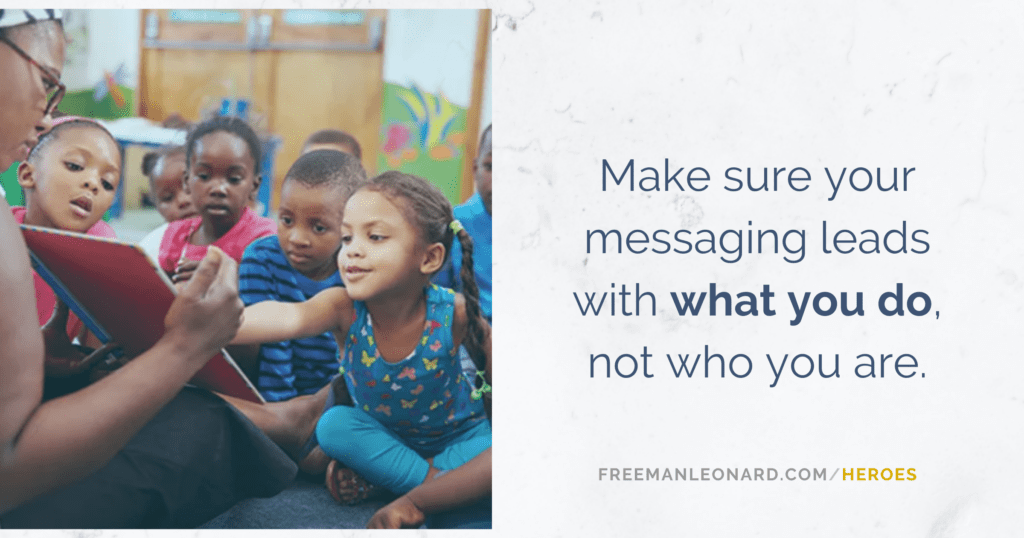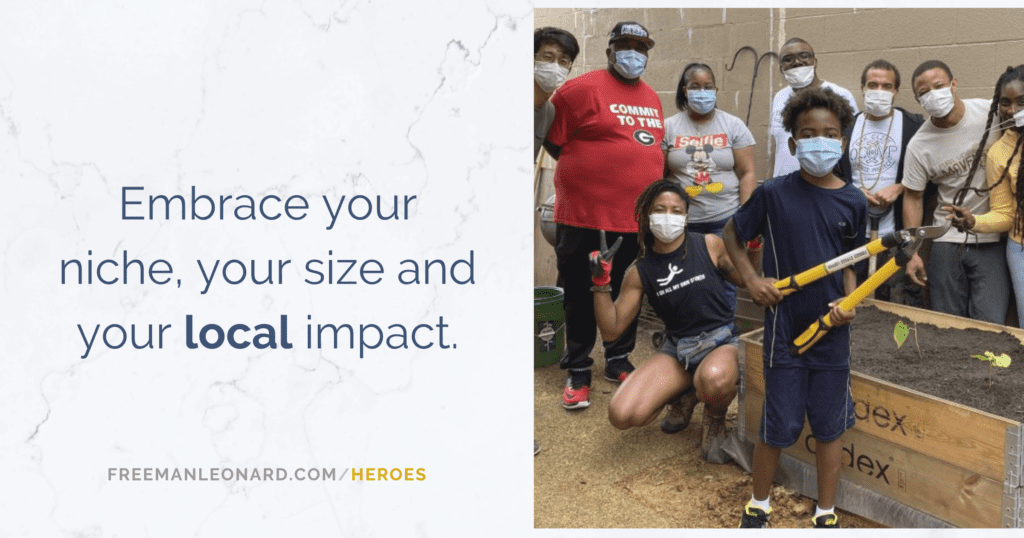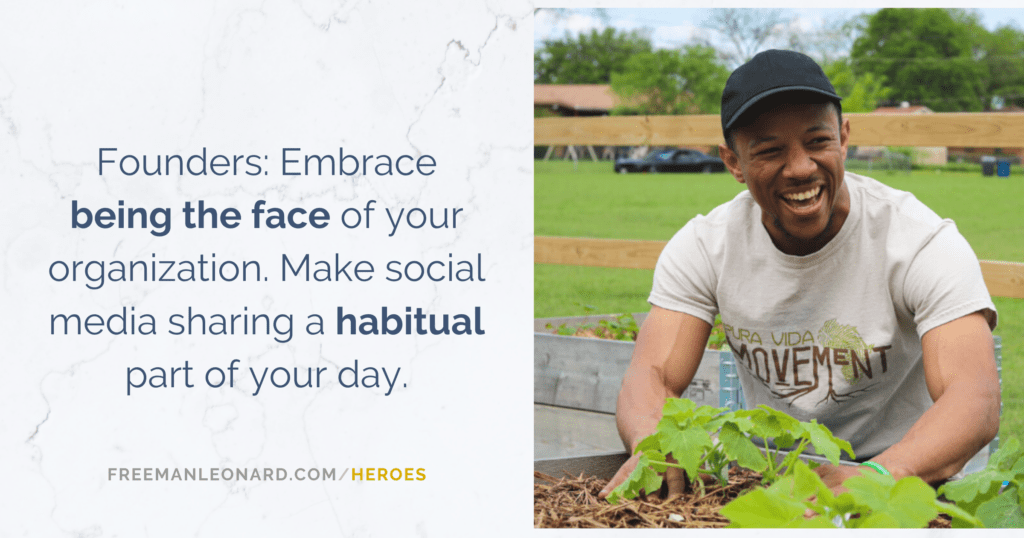View the original story on Freeman Leonard
Like many nonprofits of its size, Live Pura Vida, a 501(c)(3) based in Arlington and Fort Worth, has been hit hard by the pandemic. Revenue from for-profit arms of the organization — which typically funded the nonprofit side — had almost completely dried up.
And that meant the array of services and programming they offered — ranging from after-school programs and cultural education to dance classes and culinary instruction — could no longer be accessed by the communities and children of color who needed them.
But executive director Juleon Lewis has still worked tirelessly to reach those in his community who needed critical services like food assistance more than ever.
Then, Live Pura Vida was nominated for a special opportunity to brainstorm new strategies with some of the Dallas-Fort Worth area’s top marketing minds.
A Time for Heroes, Freeman+Leonard’s community-driven response to the COVID-19 pandemic, pairs a struggling small business owner or nonprofit leader with some of the firm’s top marketing and advertising talent for a complimentary one-hour panel and discussion. The goal: to develop new strategies and ideas to help the organization drive revenue and growth in our new economy.

“The question and the challenge that I’d like to bring to you all today,” Juleon prompted as his strategy session began, “is how can we share the message of what we’re doing in an effective and digestible manner so that we can get more awareness of our brand and what we’re doing?”
After a brief review of the Live Pura Vida brand and its current marketing, our panelists began their brainstorm.
They shared the following eight recommendations for the nonprofit, many of which could be applied to any organization in need of a post-pandemic boost, despite limited resources.

1. Leverage email marketing platforms to connect directly with your community.
Social media may be at the top of many marketers’ minds, but the real gold is in your email list. After all, it’s the only digital audience you truly own — and it allows nonprofits with even the smallest budgets to have a direct line of communication with their donors, volunteers and constituents.
“One of the easiest and most time-efficient things to do is to get an email blast going, whatever your message is,” recommended agency executive Sophia Johnson.
“If you want everybody to switch over to smile.amazon.com, that’s a quick email to your entire database. If you need volunteers, that’s an email: ‘I need volunteers in these three areas.’ I would encourage you to put together an email strategy. You can do that in a couple of hours. And it’s just about putting everybody in your database.”

2. Partner with more-established, complementary nonprofits and organizations.
For smaller organizations, collaboration is often key to reaching larger audiences and broadening awareness and reach.
Marketing executive Dorothy Jones asked, “Are you open to complementary nonprofits or groups of artists in the vocal field or the visual arts that have existing, successful curriculum?”
“You’re making such a meaningful difference in broader communities, through youth, with the focus on Latin culture and African-American culture,” shared marketing executive Jennifer Fomin. “Looking at all of those programs and channels, there might be similar organizations to reach out to to amplify what you’re already doing.”
Other nonprofits aren’t the only potential collaborators. Think beyond immediate competitors to any organization or body that reaches the same populations in other ways.
“I have to ask about partnerships with schools,” said Lisa Foster, a marketing talent specialist. “You clearly partner with after-school programs, but do you have any partnerships with schools more broadly to tap for volunteers and donations?”
There are many ways to make partnerships and collaborations work, as long as the relationship is mutually beneficial in some way. In both nonprofit and for-profit businesses, it can pay to partner up and share both resources and audiences.

3. Make sure your messaging leads with what you do.
With so many worthy causes out there competing for volunteers and donors, every nonprofit must fight to win hearts and minds and position themselves as the one to back. It’s not enough simply to exist as a 501(c)(3) — you must demonstrate results.
At every opportunity, lead with your impact when describing your organization, emphasizing what you do and who you help, rather than a boilerplate description of who you are.
This can be as simple a shift as rearranging information on a website. As Sophia Johnson pointed out, moving the “What We Do” section of the homepage to above the “Who We Are” section on Live Pura Vida’s website could help the true message sink in:
“It’s not as important who you are; it’s more important what you do.”

4. Embrace your niche and local impact.
And to that end, don’t think you need to seem bigger than you are in order to win over supporters.
Many individual and corporate donors are more focused than ever on organizations that can make a real, tangible difference in specific, targeted communities, rather than on broad, globally-focused charities.
Sophia Johnson again suggested a simple messaging shift for Live Pura Vida’s homepage, encouraging the organization to emphasize the difference it makes for children and communities of color in the Arlington and Fort Worth areas specifically.

5. Get creative with video on TikTok and Instagram Reels.
Emerging social media platforms and video formats like TikTok videos and Instagram Reels also present a fresh opportunity to creatively spread your organization’s message to new people.
And because an everyday, less polished aesthetic reigns supreme on those platforms, they also take very little production investment to create. All you need is an idea and a smartphone.
Agency executive Rob Howe explained how this could work for an organization like Live Pura Vida, whose sheer variety of programs and services for communities of color presents a messaging challenge that may be familiar to many nonprofits:
“It struck me, on TikTok and Instagram Reels, that there are dancers who are also educators and use their videos to point to different things and share information and facts,” shared Rob, suggesting that Live Pura Vida could do the same, using fun video content to share information, “be it about your nonprofit or about the people that you serve.”
After all, said Rob, “what better way to really encapsulate the entire experience, than to integrate dance with messages about the impact you have?”

6. Invest small amounts of advertising for your most important content.
Unfortunately for budget-strapped nonprofits everywhere, social media platforms — especially larger and more established ones like Facebook — are now ‘pay to play.’ Without paid amplification of some kind, it’s difficult if not impossible to widen awareness of your organization on these platforms.
“Part of the challenge of growing your social media is that a lot of the platforms continue to diminish organic reach. And so what I’d consider is, ‘What is a proper investment to simply increase your awareness?’” suggested marketing executive John Lods.
He continued, “If you’re creating content and you’re investing 5 or 10 hours to do that, very few people are able to see that content because Facebook doesn’t promote it organically.”
Thankfully, it doesn’t take a large budget to distribute that content to your intended audience with self-service social media advertising tools. Even $25 to $50 here and there can help ensure your posts are seen by the right people.
And not every post will merit the investment. Set aside a modest fund for Facebook or Instagram ads and divide it among your most significant or strategic content, messages or campaigns.

7. Create an internship program for marketing students.
It’s probably fair to say that most nonprofits are shorter on manpower than they are on ideas.
However, for new nonprofit founders especially, the idea of training junior talent can feel too time-consuming or risky to pursue. But it’s important to push past this conception to scale your organization’s impact beyond your existing team, especially if marketing has fallen by the wayside.
“We get a lot of students in marketing degree programs who are looking for internships for both summer and full-time and ongoing,” said Kathy Leonard, President & CMO of Freeman+Leonard.
“And some of those young people are in marketing and others are in social media. I’m wondering if there are unpaid internships for college credit that you could create with local universities.”

8. Get comfortable being the face of your organization, and make sharing to social media a habitual part of your day.
The best laid marketing strategy won’t take any organization very far if it isn’t implemented. For the leaders of small businesses and nonprofits alike, marketing should be approached less as a carefully crafted plan and more as a daily habit.
Furthermore, people care about people, not organizations, and they want to see the humans behind the scenes making it all happen.
For small nonprofit founders and executive directors, few strategies will take you further in reaching and engaging your audiences than embracing your role as spokesperson for your organization.
“You’ve got a great smile. I think you could be more front-and-center as the face of this organization,” social strategist Megan Van Groll suggested to Juleon. “As you go about your daily activities supporting the nonprofit and for-profit sides of your brand, you can be the face telling that story on Instagram — via selfie-style videos, explaining what you’re doing, taking people along for ‘a day in the life.’”
Shared on Instagram Stories, these behind-the-scenes vignettes can be both ephemeral and lasting, living proof of the work your organization is doing for anyone to later come along and see.
“You don’t currently have any Instagram Stories highlights,” Megan pointed out, “so you could start saving those stories to the highlights at the top of the profile.” There, they’ll always be available for future supporters to discover.
Though our economy is recovering from COVID-19 and we can now see the light at the end of the pandemic tunnel, many nonprofits and small businesses are still struggling to drive donations and revenue. Resources, both time and money, are strained.
Investing those precious resources in only the highest-impact, most strategic marketing and revenue-driving activities is never more critical than it is right now.
If you know of another small business or nonprofit that could use an injection of strategic ideas from our marketing and advertising experts, nominate them to be the next beneficiary of Time for Heroes.
“I am blown away by everyone on the call,” said Juleon at the end of the brainstorm. “The amount of experience and talent on the call is almost overwhelming. What a pleasant surprise.”
Thanks to Juleon Lewis for sharing his story so openly with us and with our community. If you’d like to support Live Pura Vida and the local communities of color they serve, you can make a donation online at livepuravida.org.



